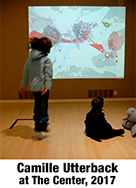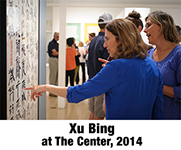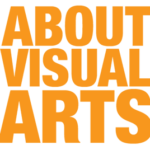The Center’s visual arts program taps into the national conversation
Did you know that nationally and internationally known artists are exhibited right here in our community in this valley?
When you walk through the doors of The Center’s museum or any event you are likely to see or experience a world-class and award-winning artist, performer or speaker.
For example, did you see the recent announcement of this year’s MacArthur Award winners? My colleagues and I were thrilled to see Viet Thanh Nguyen’s name on the list. Our community will have the opportunity to hear from him on March 8, when he closes The Center’s Lecture Series with a talk we’re co-presenting with the Community Library. Click here for more info.
 As I scrolled through the list of this year’s winners, I came across another familiar name: Trevor Paglen. Paglen is an artist and geographer who’s been making work about our national surveillance systems and agencies for the last couple of decades. I included some of Paglen’s work in a 2010 exhibition here at The Center, I Spy: Surveillance and Security. It was gratifying to see him recognized by the MacArthur Foundation for his deeply thoughtful work.
As I scrolled through the list of this year’s winners, I came across another familiar name: Trevor Paglen. Paglen is an artist and geographer who’s been making work about our national surveillance systems and agencies for the last couple of decades. I included some of Paglen’s work in a 2010 exhibition here at The Center, I Spy: Surveillance and Security. It was gratifying to see him recognized by the MacArthur Foundation for his deeply thoughtful work.
Seeing his name on the list made me wonder if there are other MacArthur Fellows whose work has been part of our exhibitions. As I started digging, I was surprised to find that work by six had been in shows here at The Center just in the past ten years.
 In 2007, my first year here, Jeanne Meyers curated a fabulous exhibition of interactive art that included work by MacArthur winner Camille Utterback. I showed lightbox photographs by Alfredo Jaar in an exhibition on mining, and Iñigo Manglano-Ovalle’s DNA portraits in a project about biology. Xu Bing’s Square Calligraphy works were part of our exhibition on contemporary China. Just this summer, Kristin Poole’s exhibition, Night Watch, featured beautiful prints by Vija Celmins; and this winter we’ll have an additional MacArthur winner taking part in This Land is Whose Land?, our consideration of the refugee crisis, will include a selection of photographs by MacArthur Fellow Fazal Sheikh.
In 2007, my first year here, Jeanne Meyers curated a fabulous exhibition of interactive art that included work by MacArthur winner Camille Utterback. I showed lightbox photographs by Alfredo Jaar in an exhibition on mining, and Iñigo Manglano-Ovalle’s DNA portraits in a project about biology. Xu Bing’s Square Calligraphy works were part of our exhibition on contemporary China. Just this summer, Kristin Poole’s exhibition, Night Watch, featured beautiful prints by Vija Celmins; and this winter we’ll have an additional MacArthur winner taking part in This Land is Whose Land?, our consideration of the refugee crisis, will include a selection of photographs by MacArthur Fellow Fazal Sheikh.
 The Center is a non-collecting museum and is accredited by the American Alliance of Museums. “Non-collecting” means we borrow or commission every artwork we show. We borrow from artists, galleries, museums and private collections. The fact that we don’t collect means we have the opportunity to exhibit work that engages with the most relevant issues and ideas of our times. It also means we have the luxury of showing work that might not fit into a private home—either literally, because of its size (Michael Salter’s giant Styrobot!), or because the subject matter it tackles might not be something you’d want to live with every day.
The Center is a non-collecting museum and is accredited by the American Alliance of Museums. “Non-collecting” means we borrow or commission every artwork we show. We borrow from artists, galleries, museums and private collections. The fact that we don’t collect means we have the opportunity to exhibit work that engages with the most relevant issues and ideas of our times. It also means we have the luxury of showing work that might not fit into a private home—either literally, because of its size (Michael Salter’s giant Styrobot!), or because the subject matter it tackles might not be something you’d want to live with every day.
As a non-collecting museum, we are lucky to be able to bring art to this valley that is made by artists working at the top levels of the contemporary art world. The school children and adults who tour our tiny space have the opportunity to see work not just by MacArthur Fellows, but Guggenheim Award winners (Kim Abeles, Carl Andre, Vija Celmins, Mahwish Chishty, Russell Crotty, Beverly Fishman, Joyce Kozloff, Nicholas Lamia, Iñigo Manglano-Ovalle, Stephanie Syjuco). They get to have intimate experiences with work by artists who have participated in the São Paulo Bienal (Mark Dion, Allan McCollum, Vik Muniz), the Venice Biennale (Tiffany Chung, Spencer Finch, Theaster Gates, Vik Muniz, Michal Rovner, Kiki Smith) and the Whitney Biennial (Spencer Finch, Theaster Gates, Kiki Smith). They sometimes have the chance to experience work by 20th-century artists who changed the trajectory of modern art (Arthur Wesley Dow, Sol LeWitt, Helen Lundeberg, Lee Mullican) or artists who shape the narrative of the history of American art at the Whitney Museum (James Castle, Helen Frankenthaler, Agnes Martin, Agnes Pelton, Fred Sandback, Richard Tuttle).
I think that architecture, for better or for worse, sets expectations. Walking into our humble museum, one might not expect to encounter any of the names on this list. As I read through it myself, I feel incredibly fortunate that we have been to be able to share work by these Did. And while showing work by well-known artists is always important to our curatorial goals, we’re equally focused on giving opportunities to younger and emerging artists, particularly when we can commission a new body of work or a site-specific installation. It’s exciting to think about which of these lesser-known artists might someday represent the U.S. in Venice or be part of the national conversation at the Whitney Biennial. And it’s equally exciting to think about whose work might fill our space in the next ten years!




